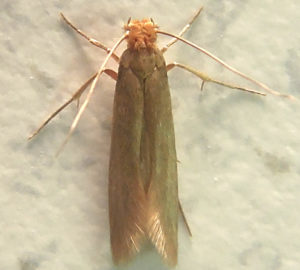
Webbing Clothes Moth, Tineola bisselliella. (Patrick Kelley, Insects Limited, Inc.)
Generations of people have grown up at the Royal BC Museum. This includes the babies that come in strollers with their parents, the multitudes of youth that visit with their school groups, college students who find summer employment as camp leaders, tourists, parents and grandparents. Museums attract them all. Museums also attract insects. Vast collections of furs, feathers and textiles – on exhibit and in storage – provide a tempting food source for young larvae.
The adult insects arrive on the clothes of staff and visitors, through cracks in the walls and under door sweeps. Occasionally, these opportunistic interlopers find their way to collections, where they settle down to raise their families. Their needs are basic; a quiet place in the dark that is free of predators, a nice stable climate and an ample source of food. A bear skin rug, woolen uniform, or a cozy moccasin is move-in ready.
After they take possession of their lovely new home, the eggs are laid and not long after, the larvae hatch. The larvae create their very own receiving blanket, a sort of cocoon made of extruded silken material mixed with fibres stolen from the artifact around them. Larvae are hungry little beasts and waste no time beginning to feed … on their own home of all things! This is where the story gets scary. Those furs, feathers and textiles can be digested at lightning speed, leaving nothing behind but frass, or tiny fecal pellets. The damage is done, and often it is devastating.


